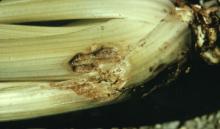Cause Sclerotinia sclerotiorum is a cosmopolitan fungus that occurs across the globe, infecting a very large number of plant species including radish and Brassica crops. Other susceptible host plants include bean, carrot, pea, lettuce, potato, green pepper, cucurbits, parsnip, radish, sunflower, herbs including mint, fruit trees including apple, nectarine, and sweet cherry, and a large number of ornamentals both woody and herbaceous. Weeds can also be host to S. sclerotiorum; dandelion (Taraxacum officinale) is a very susceptible weed host. Stem infections can cause severe losses in seed crops.
This fungus survives as sclerotia, which may be associated with infected plant residues, contained in seed lots (external or internal to seed), or persist in the soil. Sclerotia can survive three to five years in the soil, depending on environmental conditions and cropping practices. Typically, strains of this fungus outside of tropical zones require a conditioning period in moist soil of several weeks at 40°F or cooler temperatures, after which sclerotia can germinate in soil when the soil water potentials are ≥-100 kPa and temperatures are between 41°F and 68°F. The production of apothecia appears to be prevented when soil matric potentials are below -0.05 MPa. The upper temperature threshold for conditioning and germination of sclerotia is 68°F and 77°F, respectively. Typically, sclerotia germinate and then produce a small, stalked, cup-shaped fruiting structure known as an apothecium, which forcibly ejects millions of ascospores into the air. Sporulating apothecia may persist five to ten days while released ascospores can survive up to two weeks, depending on environmental conditions. Since ascospores require an exogenous nutrient source before infecting a plant, the primary sites for initial infection are senescing tissues such as spent blossoms and declining leaves or plant tissues that have suffered mechanical injuries or wounding through infection by other pathogens. For infection, ascospores require free moisture or a relative humidity close to 100% with a temperature between 50°F and 86°F. Sometimes sclerotia germinate and produce undifferentiated mycelium that directly infects plant portions just below or at the soil line. After infection of the plant has occurred the mycelium spreads by hyphal growth, the fungus can then invade any healthy, vigorous part of a plant with which it comes in contact, and the pathogen may grow from plant to plant if a diseased plant is in direct physical contact with neighboring plants. Moist conditions within the plant canopy favor infection, as do rain, dew, and/or irrigation practices that keep foliage wet for long periods.
Symptoms The disease is mainly on aboveground parts, producing a cottony white mold. As leaves decay, small white bodies appear in the mold and gradually change from white to black as hardened sclerotia develop. The disease frequently occurs in storage. This organism can cause damping-off of seedlings. In mature plants, the disease appears as a basal rot of crown and petiole. Decay is watery and fairly rapid. It turns pink and later is covered with white mycelium. In later stages, the white mycelium is covered with hard, black sclerotia. Frequently found after black heart.
Cultural control
- Reduce humidity and high-moisture periods within the plant canopy and field.
- Provide adequate aeration within, and especially between, rows by increasing plant and row spacing or trimming celery foliage.
- Orientating the rows in the direction of prevailing winds is useful for white mold control if the placement of irrigation equipment allows row orientation.
- Time irrigations to allow drying of plant canopy before nightfall or use subsurface drip irrigation; keep the top 2 to 3 inches of bed dry.
- Apply sufficient nitrogen to meet crop demands, but avoid excessive fertilization that can lead to dense, lush plant growth.
- To reduce pathogen population within a field:
- Rotate with non-hosts (grasses and cereals) for 8 years to achieve best control, but for at least 2 years to reduce population of sclerotia.
- Deep plowing buries sclerotia but plowing later years may return viable sclerotia to the surface.
- Where feasible, field flooding during warm temperatures destroys sclerotia.
- Cull and clean celery before placing into sanitized containers for storage. Store at 32°F and prevent condensation.
Chemical control No fungicide listed is likely to control pink rot enough to justify the expense of application for this disease alone.
- Botran 5F (Group 14) at 2 to 3.2 quarts/A. May be applied up to 7 days before harvest. 12-hr reentry.
- Endura (Group 7) at 8 to 9 oz/A, at least one week apart. To limit the potential for development of resistance, do not make more than two (2) applications of Endura per season. The preharvest interval is 0 days. 12-hr reentry.
Biological control
- Bexfond at 7 to 14 fl oz/A. 4-hr reentry. O
- Serenade Opti at 14 to 20 oz/A on 14-day intervals beginning 8 weeks before harvest. Applications can be made up to and the day of harvest. 4-hr reentry. O
- Stargus at 6 to 8 fl oz per 1,000 ft row as an in-furrow treatment, 3 to 4 quarts/A as a soil drench (drip or chemigation) on 10- to 21-day intervals, or 2 to 4 quarts/A as a foliar spray on 7- to 10-day intervals. Preharvest interval is 0 days. 4-hr reentry. O
Note Rotting celery contains high levels of toxins that react in sunlight to cause severe dermatitis in fair-skinned workers. Persons working in celery in sunny weather should wear gloves, long-sleeved shirts, and long pants.
References Caesar, A.J., and Pearson, R.C. 1983. Environmental factors affecting survival of ascospores of Sclerotinia sclerotiorum. Phytopathology 73(7):1024-1030.
Hao, J.J., Subbarao, K.V., and Duniway, J.M. 2003. Germination of Sclerotinia minor and S. sclerotiorum sclerotia under various soil moisture and temperature combinations. Phytopathology 93:443-450.
Mila, A.L., and Yang, X.B. 2008. Effects of fluctuating soil temperature and water potential on sclerotia germination and apothecial production of Sclerotinia sclerotiorum. Plant Dis. 92:78-82.


